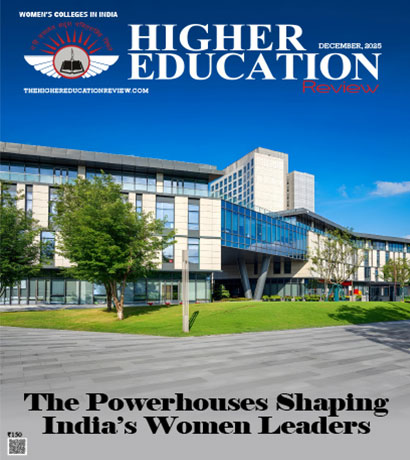How AI & Agentic AI Will Transform Education in the Next 3 Years
 Andrew Dutta, Dean Academic at XIM University, Bhubaneswar, in an interaction with Higher Education Review, shared his views on how Agentic AI is redefining the future of education, how the action of teaching is transforming, and how learning methods are being redefined. He highlighted how educational leaders have to adapt and use AI in learning, teaching, and assessments in order to adapt in a world that is constantly evolving. He mentioned how AI can help in bridging learning gaps, personalizing education, and enhancing productivity.
Andrew Dutta, Dean Academic at XIM University, Bhubaneswar, in an interaction with Higher Education Review, shared his views on how Agentic AI is redefining the future of education, how the action of teaching is transforming, and how learning methods are being redefined. He highlighted how educational leaders have to adapt and use AI in learning, teaching, and assessments in order to adapt in a world that is constantly evolving. He mentioned how AI can help in bridging learning gaps, personalizing education, and enhancing productivity.
As Agentic AI enables autonomous learning agents for students, how will this influence the need for traditional instructional methods over the next three years?
In the future, society will likely be divided into two categories: those who know how to use AI and Agentic AI effectively and those who fall behind. If educational leaders, including vice chancellors, directors and policymakers fail to implement AI into teaching, learning and assessments, educators and students may become out-dated. Traditional instruction methods, such as chalk-and-talk and traditional classroom delivery in higher education are changing rapidly. In education and other sectors, those who fail to adapt AI are inevitably left behind. The responsibility now lies with individuals and institutions to proactively align with the evolving AI landscape in order to remain competitive and future-ready.
How might AI and Agentic AI help bridge learning gaps in under-resourced communities, and what transformations can we expect by 2028?
Government has the potential to foster the growth of homegrown AI companies within the edtech sector. India has many homegrown companies in this space, many of which are expanding their social objectives alongside business goals. In order to ensure inclusive growth, a multi-modal approach such as initiatives led by the government, public-private partnerships, and socially driven enterprises is required. This multi-modal approach ensures that those people who are economically backwards will not be excluded from the advantages of AI in education.
India is resource-rich nation, and it has one of the most competitive workforces in the world. In the past decade, the Make in India program has significantly improved the country's global economic standing. State governments, particularly those that have not yet considered making these reforms need to get involved and actively engage in transforming India through technology. Investment at the bottom level, especially in technology, is essential.
With rapid advancements in AI-powered assessments and adaptive testing, how will evaluation methods in education evolve in the next three years?
The traditional assessment approaches, whereby students take closed-book exams, no longer remain the sole approach to assessment. It is important to revise school and college level assessments. The shift should be on more progressive methods such as open-book exams and open-network examinations to change the paradigm away from memory-based examinations to application-based assessment. This change reflects a broader transformation in education - moving away from rote learning to fostering critical thinking. The National Education Policy (NEP) 2020 assists this transition by providing autonomy to learners and institutions. The new National Education Policy (NEP) 2020 allows students and institutions more autonomy to create new courses and learning platforms.
As the examination system changes, students will be expected to demonstrate their competencies with increasing resources. The focus should be on the application of their competencies around critical thinking, problem solving, and depth of understanding. It will be the responsibility of leading educational institutions to drive and collaborate with government bodies and public institutions to ensure that this transformation occurring in educational system. A partnerships need to take place to redefine assessments to fit the demands of a changing educational system.
How will the rise of AI tutors and Agentic AI companions impact the role of peer-to-peer learning and collaborative education?
When students are truly committed to learning they may use Agentic AI as AI tutors or learning agents. The agents identify the student’s needs and provide customized, personalized support based on the student’s particular pattern of thinking, and individual pace. This next phase of AI changes the relationship of the student with the teacher, whether the student is in school or in college. AI has the power to improve the agency of students and teachers, providing an opportunity for teachers to make their teaching more effective, and personal. Ultimately there is no substitute for the human touch. However, when human insight is effectively complemented by the capabilities of artificial intelligence and individuals who harness this synergy will be well-positioned to lead and excel in the future workforce.
As education systems increasingly adopt AI for administrative and analytical tasks, how will this shift institutional priorities and strategies in the next three years?
AI is not just limited to education. It exists in almost all facets of human life. One of the main benefits is its ability to analyze data. AI can analyze large Excel data or many pages of PDF reports within minutes. AI can handle tasks in a few minutes that would typically take a long time. This significantly saves time and increases productivity. Additionally, reverse mentoring has become increasingly essential. AI can act as an enabler. For those in senior leadership roles, it is important to adopt AI to save time, boost productivity, and extend these benefits to others. That's when AI can really excel.

